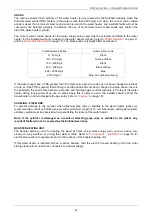
43
CONNECTIONS – ELECTRICAL
The power supply to the water heater must not be switched on until the water heater is filled with
water
and a satisfactory megger reading is obtained.
All electrical work and permanent wiring must be carried out by a qualified person and in accordance with the
Wiring Rules AS/NZS 3000 and all local codes and regulatory authority requirements.
If this water heater is installed with an in-series booster, then the electric booster heating unit will not need to
be connected to a power supply and the references to the electric booster heating unit, thermostat and
boosting controls in these installation instructions will not be applicable to the installation.
Note:
AS 3498 requires that a water heater provides the means to inhibit the growth of Legionella bacteria in
potable water. This water heater can satisfy this AS 3498 requirement provided the electric booster is
energised for a sufficient period each day and the electric booster thermostat setting is 60°C or higher.
The power consumption of the water heater is:
Component
Power
consumption
Comments
Solar controls
4 Watts
Constant load - differential controller
Solar circulator
36 Watts
Maximum load at solar heating cycle start up
30 Watts
Average load during the solar heating cycle
Booster heating unit
2400 or 3600 or
4800 Watts
Load when heating unit is operating
The water heater will only operate on a sine wave at 50 Hz. Devices generating a square wave cannot be
used to supply power to the water heater.
SOLAR STORAGE TANK
The solar storage tank with an electric booster heating unit must be directly connected to a 240 V AC 50 Hz
mains power supply with an isolating switch installed at the switchboard.
A flexible 20 mm conduit is required for the electrical cable to the solar storage tank. The conduit is to be
connected to the unit with a 20 mm terminator. Connect the power supply wires directly to the terminal block
and earth tab connection, ensuring there are no excess wire loops inside the front cover.
The water heater is most suited for the booster heating unit to be connected to either a continuous, or a time
of use, or an extended Off-Peak (overnight and day) electricity supply. A timer can also be used to control
the boosting periods and help maximise solar savings. Refer to
on page 45.
The booster heating unit may be connected to an Off-Peak (overnight) electricity supply, however this will
only allow the booster to heat the water overnight. If this type of connection is considered, care must be
taken to ensure there is sufficient boost capacity to meet
the household‟s full day and night‟s hot water
supply during periods of no or low solar gain, particularly in cold weather.
Discuss the power supply and hot water usage requirements with the householder.
The solar control unit is supplied with a power cord to be plugged into a general purpose outlet (GPO). Refer
to
on page 44.
Содержание Streamline 270MDV
Страница 51: ...51 This page is intentionally blank ...
Страница 52: ...52 This page is intentionally blank ...














































